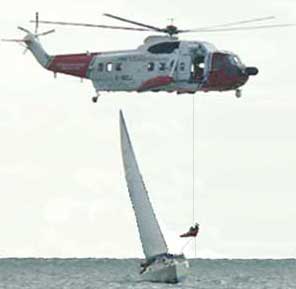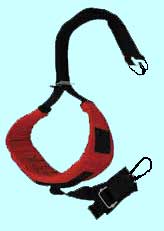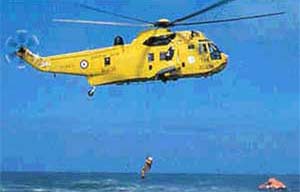Helicopter Rescues at Sea
Helicopter rescues
In the UK, helicopters tend to use a hi-line transfer to pick up casualties from a yacht.
On a sailing boat this is done under sail if there is sufficient wind. The  boat should sail close hauled on port tack. This means that the down draft from the helicopter strikes the water to one side of and astern of the boat, if this did not happen the yacht could be very difficult to control.
boat should sail close hauled on port tack. This means that the down draft from the helicopter strikes the water to one side of and astern of the boat, if this did not happen the yacht could be very difficult to control.
The normal arrangement for a pick up from a motor vessel, is for the vessel to proceed in the direction and at the speed given by the helicopter pilot.
The aircrew drop a long line with a weight on the end first.
The crew of the yacht pull this in, it is about 30m long. Because of the length of line it needs to be carefully tended, most crews find putting it in to a large bucket keeps the line clear of obstructions. In anything of a seaway, the line may be pulled out of your hands as the boat passes over waves, so a pair of gloves are invaluable, I also recommend that the person handing the line be clipped to the boat.
The diver is then lowered on the main lift wire, he drops an earthing cable in to the water when he is at deck level.
The diver is pulled on the the deck by the crew of the yacht, as the hatch and winch of the helicopter are on the starboard side, this will happen to the port quarter of the yacht. For this reason, when you are fitting out your vessel, you should try to keep all the aerials or other obstructions on the starboard quarter if possible. 
Once the diver is on the boat he will give directions, if he needs to remove a casualty he may call for a stretcher to be lowered, or may lift the casualty in a lift strop that is passed under the arms.
To reduce the risk of post rescue collapse (see cold water survival video) caused by lifting a hypothermic victim in a vertical position from the water, a special double strop can be used that lifts the patient horizontally.
Important points
If a helicopter is sent to your assistance, there are several points to consider.
- Communication is impossible once the helicopter is overhead, brief the crew before it arrives
- Have a hand held flare ready to pinpoint the vessel (imagine trying to find a specific boat in a busy area like the Solent on a summer day)
- The helicopter crew will contact you by VHF radio, monitor the radio, but do not transmit unless called as the pilot is listening to the winch man giving him directions on the approach
- Either motor directly in to the wind with the sails down or sail close hauled on port tack (the helicopter crew will instruct you)
- The helmsman must concentrate on steering a straight course
- Clear the decks of any loose equipment that may blow away or be sucked in to the engine intakes.
- Have a bucket ready to lower the winch line into, gloves may be useful
- Do not attach the cable to the yacht, or let it snag on anything
- When the cable is lowered, let it earth out on the deck or water before touching it (there is a static build up in flight)
- Follow the diver's hand signals when he has been lowered
- When he has been lowered to deck level, you pull him in to the boat
- Follow the diver's instructions when he is on the boat
A helicopter crew perform, hundreds of rescues each year, follow their instructions exactly, they know what they are doing!
Sometimes it is possible to call the coastguard and ask to take part in a training exercise. The air crew of rescue helicopters on the south coast of the UK practice virtually everyday of the year.
If you are in the area they are practicing in they may be prepared to arrange to drop a crew man on to your vessel. This is one of the best ways to find out what is really involved and to help you to plan for what to do if you ever need to do it for real.
In the winter when there are not many yachts about it is not unusual for a helicopter to fly up to a yacht and hang a sign out of the side, indicating they wish to communicate on channel 67. They will then ask to exercise with you and give you a detailed briefing.
The experience of having a Seaking helicopter hovering a couple of metres above your mast will probably be one of the most exciting things that will happen to you that day, so if you get the chance don't  turn them down.
turn them down.
If the sea-state is too rough for a man to be lowered to the deck, the helicopter may lift you from a liferaft or dinghy. Occasionally you may be told to jump into the water and be rescued from there. In this case ensure you are wearing lifejackets and only enter the water one at a time when told to.
Anthony Hicks web site has a video of a helicopter rescue demonstration.
Some years ago the RYA made a training video (Life on the Line) that covered several rescue scenarios, this includes a detailed explanation of the different stages of a helicopter rescue. This video is no longer available but many clubs have it in their libraries. The helicopter rescue proceedure in this video is shown with the yacht motoring in to the wind, whilst this is still possible, the sequence outlined above in the preferred method with most UK coastguard helicopters.
Sailtrain.co.uk is free to use, but if you feel you would like to contribute to the running and development costs you can donate via Paypal:
Additional Resources:

